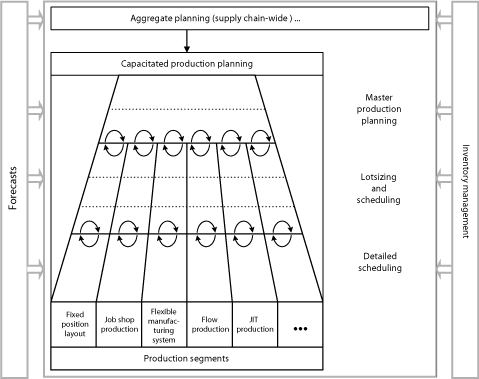Operative Planning
Operative production planning deals with the medium-term to short-term decision making related to the production processes and the associated logistical processes. The structure of a hierachical planning system is depicted in Figure 1. (See Tempelmeier, H., Inventory-Management in Supply Networks, 2nd Ed., Norderstedt(Books-on-Demand) 2011).

Figure 1
This planning structure has several planning levels where for each level specific planning models are defined. According to the mainstream of production and operations management textbooks, the aggregate planning level focuses on the general course of action to find a production plan which reflects the dynamics of the aggregate demand forecasts as well as the costs associated with the building up of inventory and the use of overtime and/or variable workforce levels. The planning horizon is often one year or more. The resulting plan shows the development of the production and purchasing quantities as well as the usage of the resources over time. The planner is taking a longer perspective and minimizes the negative effects of short-term variations. The variables and constraints are defined in aggregate units. As the decision maker has an aggregate view of the problem, he is allocated to a higher level in the production planning hierarchy. In companies running multiple factories located in different parts of the world, the aggregate planning task covers the coordination of the production quantities among these factories, including planning of transportation.
Located immediately below the aggregate level, on the master production planning level, the specific timing and sizing of production quantities of main products or finished products are defined, thereby possibly taking the multi-level structure of the production processes into account. The resulting master production schedule defines the external demands that must be met through production activities for sub-assemblies and components. In the standard MRP approach this planning level is called ”Master Production Scheduling” which has up to now mainly been treated without a formal decision model.
The next planning level considers the specific problems which arise in the different production layouts. Here, different types of lot sizing problems, as mentioned above, arise in combination with different layout-specific scheduling and sequencing problems. Figure 1 emphasizes the segmented structure of this layer of production planning. The depicted segmentation of problem types and resulting decision models, in addition to the explicit consideration of the limited capacities of the resources, is a significant characteristic which distinguishes the capacity-oriented production planning from the standard MRP approach.
For the solution of the above-mentioned planning problems, the operations management literature provides a wide variety of planning approaches which are in part implemented in so-called Advanced Planning software systems (APS)12. It is a common property of most of these approaches, such as aggregate production planning, master planning as well as lot sizing, that planning is based on forecasts of future demands which are treated as deterministic data in the planning process. That means, not only the external demand quantities but also the flow times (including waiting times caused by bottlenecks or machine breakdowns) as well as the scrap rates which in some industries are significant, are treated as deterministic factors.